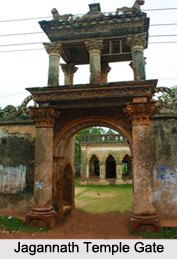 Sainthia is an area in Birbhum District of West Bengal. This place contains a shrine of Goodess Nandeswari. Sainthia is a satipith where the collar bone of Goddess Sati fell.
Sainthia is an area in Birbhum District of West Bengal. This place contains a shrine of Goodess Nandeswari. Sainthia is a satipith where the collar bone of Goddess Sati fell.
Location of Sainthia
Sainthia, formerly Nandipur, is a large town and a municipality in Suri Sadar subdivision of Birbhum district in the Indian state of West Bengal. Sainthia is known as business city of Birbhum District of West Bengal. The town is in the Jurisdiction of Sainthia police station. Sainthia is the fourth most populous town in Birbhum district and 991st most populous town in India. Sainthia is known as business capital of Birbhum district. The town is famous for Nandikeshwari Temple, one of the Shakti Peethas in India. Sainthia Municipality has an area of 16 square kilometers.
History of Sainthia
Sainthia became popular in 16th Century with the advent of textile trade in Birbhum District. The urbanization of this area gained momentum in the recent past, when construction work of the Sahibganj loop line and a bridge over the Mayurakshi River started. The construction of the Khana-Rajmahal section of Sahibganj Loop was completed in October 1859. The first train ran from Howrah to Rajmahal via Khana Junction on 4 July 1860. The construction of the Sainthia railway station was done as part of building the entire line. This large project brought people from different corners of this country to assemble and settle here. Sainthia, an old village trade centre, a place of pilgrimage has been emerged into a municipal town in the year 1987.
Population of Sainthia
According to the Population Census in the year 2011, Sainthia Municipality has a population of 44,601, of which 22,856 are males while 21,745 are females, as per the report released by Census India 2011. The population of children under age 6 is 4511, which is 10.11% of the total population of Sainthia. In Sainthia, the female sex ratio is 951, against the state average of 950. The child sex ratio is around 880, compared to the West Bengal state average of 956.
Education of Sainthia
The literacy rate of Sainthia is 79.50%, higher than state average of 76.26%. Male literacy is around 84.70% while female literacy is 74.08%. Out of the total population, 16,485 were engaged in work or business activity. Of this, 13,481 were males while 3,004 were females.
Economy of Sainthia
Sainthia is an economically important town and one of the busiest business hubs in the middle part of West Bengal. The economy of Sainthia Municipal area is the central place of Birbhum district. The economy is based on agricultural products and their allied businesses. Rice mills, mastered oil mills, bran oil mills, fried rice mills, galvanized wire product units and other businesses run here. The economy of Sainthia stands tall due to the sales of agricultural products. The town is very much famous for export and import center for cottage industry and agricultural based different goods. The hinterland of business of Sainthia spreads up to the district of Jharkhand in the west and Kandi of Murshidabad district in the east. The town is well connected to Beharampur, Siuri, Rampurhat, Bolpur, Andal, Asansol, Durgapur and Kolkata through high roads and railroads.



















